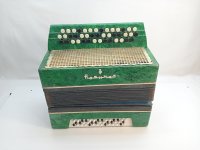Walker
🪗
Hi all.
I know very little about the CBA! So I wanted to ask a question about one particular feature of the 5 row (C system) button accordion that has intrigued me.
It's to do with the 87 button (converter instruments) without cassotto, but with 3 (LMM) or 4 (LMMH) treble voices.
Okay, so it seems 5 row CBAs with 87 buttons tend to have rows of buttons: 17 - 18 - 17 - 18 - 17
Now, as we know, the number of buttons on the three outer rows (17 - 18 - 17) gives a total of 52 notes.
So, it has always been my understanding that there can be a variety of note ranges on a 87 button instrument ranging from 46 notes to 52 notes (depending on the number of dummy buttons).
Now, from what I have seen many 87 button instruments with converter but without cassotto have a depth of approximately 21 cm. This seems to be the case regardless as to whether they have 3 treble voices or 4 treble voices. The pattern seems to be that 3 voice instruments may often have 52 notes and 4 voice instruments may often have 46 (sometimes 47) notes.
So here is my question...
Does a 52 note, 3 voice instrument require 4 reed blocks (rather than 3)?
What is the 'cut off' number of notes on a button accordion treble before it generally has more treble reed blocks than 'voices'?
Hope that wasn't too painful to get through.
I know very little about the CBA! So I wanted to ask a question about one particular feature of the 5 row (C system) button accordion that has intrigued me.
It's to do with the 87 button (converter instruments) without cassotto, but with 3 (LMM) or 4 (LMMH) treble voices.
Okay, so it seems 5 row CBAs with 87 buttons tend to have rows of buttons: 17 - 18 - 17 - 18 - 17
Now, as we know, the number of buttons on the three outer rows (17 - 18 - 17) gives a total of 52 notes.
So, it has always been my understanding that there can be a variety of note ranges on a 87 button instrument ranging from 46 notes to 52 notes (depending on the number of dummy buttons).
Now, from what I have seen many 87 button instruments with converter but without cassotto have a depth of approximately 21 cm. This seems to be the case regardless as to whether they have 3 treble voices or 4 treble voices. The pattern seems to be that 3 voice instruments may often have 52 notes and 4 voice instruments may often have 46 (sometimes 47) notes.
So here is my question...
Does a 52 note, 3 voice instrument require 4 reed blocks (rather than 3)?
What is the 'cut off' number of notes on a button accordion treble before it generally has more treble reed blocks than 'voices'?
Hope that wasn't too painful to get through.
Last edited:


